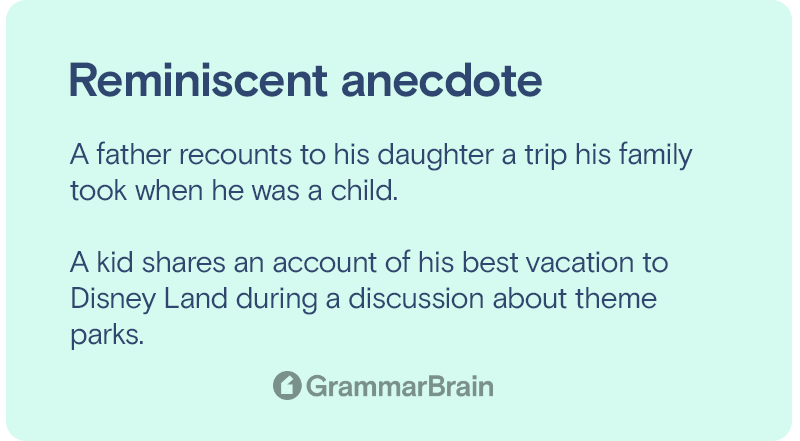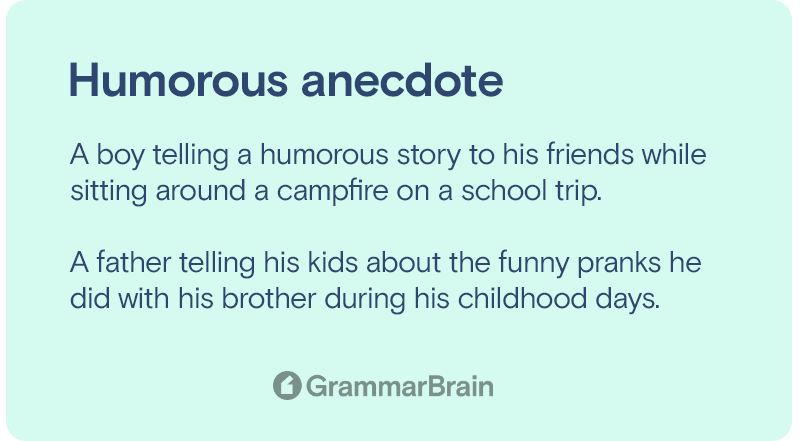

What is an anecdote? How does an anecdote work? Anecdotes are short stories about interesting topics that typically have a single lesson or theme. Anecdotes are almost similar to stories that friends tell among themselves. But, when employed in literature, they may do more than just pass the time.

Anecdotes are stories that are self-contained and brief. The majority of anecdotes focus on a single, straightforward theme or incident. They can be factual or made up or can be a real incident mixed with some embellishment.
Anecdotes can be conveyed using different tones, ranging from lighthearted jokes to grave warnings. They also typically concentrate solely on one character.
| Device | Definition |
| Anecdote /ˈanəkˌdōt/ (noun) | a short amusing or interesting story about a real incident or person. |
Anecdotes can be used for a number of purposes. Anecdotes, when used in both nonfiction and fiction as a literary device, have a greater significance.
For instance, some anecdotes provide the readers with a better grasp of a character’s background or motivations by describing them in a manner that doesn’t match the central narrative.
They are used to introduce backstory or character information. Authors usually use them to share some past story of their character usually to provide substance and intrigue.
They also offer a good way to fill in plot holes in the narrative or to impede its flow. And are typically used in real life to convey an important message in a lighthearted way rather than a direct explanation.
Good anecdotes use rhetoric to their advantage. Sentimental language is usually used in inspirational anecdotes to touch the heart of the listener or reader.
Similarly, authors may use profanity or slang in humorous anecdotes to make them appear even funnier.

There is no formal classification of anecdotes. But they can be broadly divided into different groups based on the purpose they serve.

Anecdotes can be used by elders or experienced people to motivate youngsters by describing the challenges they have faced in their lives and how they are willing to assist them. Inspirational anecdotes are a powerful writing technique that can be used to evoke specific emotions in the reader.
This is an especially effective technique in emotional and persuasive writing. Inspirational stories frequently center on extraordinary experiences that occurred to regular individuals that the listener or reader can relate to.
Writers frequently use motivational stories to emotionally appeal to their readers. These stories can convince the readers that difficult times will pass after some time and better days are ahead.

The majority of anecdotes focus on the past. In anecdotes, people usually look back fondly on special periods of their lives and share the happiness of those times with others. These fond tales usually build an idealized view of the past by evoking feelings of longing or nostalgia.
But this reminiscing may not always be happy. Sometimes depressing memories can creep up in the stories, giving rise to a feeling of melancholy or despair.

Anecdotes started out as stories that people would share in groups to amuse one another. Writers now use jokes to convey a much more complex topic in a lighthearted way. A humorous anecdote can be used to cheer people up following a significant or dramatic plot development in a story.
Similarly, it can also provide audiences or readers with a brief diversion from the main plot and give them something to laugh about.

Anecdotes are always concise and focused. This makes the perfect tool for imparting an important lesson or message to the readers. Such “cautionary tales” often feature irresponsible or flawed individuals who suffer punishment or unfavorable outcomes by doing the wrong thing.
Religious parables, fairy tales, and historical myths all use cautionary anecdotes to inspire people to act morally by illustrating the consequences of doing otherwise.
Anecdotes are frequently employed in literature to give characters more depth by highlighting aspects of their personalities or prior experiences that don’t directly relate to the central story.
This strategy is also applied in real life, frequently with historical figures and celebrities to emphasize specific qualities or traits.
Writing anecdotes isn’t difficult. Anecdotes can be used in a myriad of forms of writing, including general fiction and non-fiction works, speeches, essays, and even school or college works.
Using anecdotes while writing improves the writer’s skills and makes the text engaging. There are some tips writers can use to craft excellent anecdotes.
Many writers think that, despite having fewer words, crafting anecdotes takes more effort and time. Sometimes the writers may need to express their thoughts in a limited number of words. All these can make using anecdotes a bit difficult.
The first step to crafting a good anecdote is to define the purpose or intention of the text, whether it is to make the reader laugh or to give some serious advice.
After this objective is clear, writers can design their anecdotes around it.
Essays usually begin with an introduction that gives the reader an idea about the topic that is about to be discussed in detail. But writers can forgo this by using anecdotes and jumping directly into the story.
When compared to boring introductory paragraphs, using quirky anecdotes, in the beginning, can easily hold the attention of the readers.
Many famous fiction writers, like Malcolm Gladwell, use this technique to capture the attention of readers.
An anecdote is brief, so it is important to stay true to its purpose and not include unnecessary details. Rereading the writing while viewing it from the perspective of another person can help writers identify unnecessary details in the text.
The target audience must always be taken into account. For example, while employing scientific terminology, writers should be prepared for the possibility that some listeners won’t comprehend what they’re saying.
It’s best to choose the alternative collocation because further explanation will just make things worse.
The writers should make sure that the readers will be able to tell when the anecdote is ending. Writers can use terms like “and that’s what happened” to indicate the end of anecdotes. The ending of anecdotes is heavily dependent on the message they put forth.
Anecdotes are typically one or two paragraphs long at most. Stories are much longer than anecdotes. When writers create stories, they have far more room for detail and put more work into making the readers feel immersed in the narrative.
What are the things a writer can include in anecdotes?Anecdotes, as they are meant to be brief, typically center on a single main character, with very little information about supporting characters.
The narratives are also similarly kept simple by typically concentrating on just one conflict or subject.
Anecdotes rely heavily on rhetoric to create the desired mood. Experienced writers who use anecdotes focus on the language they use to ensure it reflects the tone they are striving for.
How are anecdotes structured?Anecdotes typically have a start, middle, and conclusion, like any other form of narrative. The characters and overarching ideas are introduced at the start, the conflict or action of the narrative is presented in the middle, and everything is resolved at the conclusion.
The structure of anecdotes is similar to that of stories, but everything is considerably shorter.
Anecdotes are by nature brief and straightforward; therefore, they typically follow a more rapid pace with fewer specifics.
What’s the difference between a short narrative or brief tale?Both types are considered short stories. When referring to short stories, they are the same as a brief tale or short narrative.